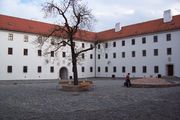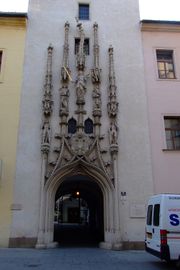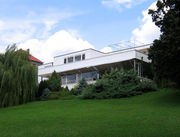Brno
| Brno | |||
| City
|
|||
|
View of Brno from the Špilberk castle.
|
|||
|
|||
| Country | |||
|---|---|---|---|
| Region | South Moravian | ||
| District | Brno-City | ||
| Parts |
29
|
||
| Rivers | Svitava, Svratka | ||
| Elevation | 237 m (778 ft) | ||
| Coordinates | |||
| Highest point | |||
| - elevation | 425 m (1,394 ft) | ||
| Lowest point | |||
| - elevation | 190 m (623 ft) | ||
| Area | 230.19 km² (88.9 sq mi) | ||
| - land | 225.73 km² (87 sq mi) | ||
| - water | 4.46 km² (2 sq mi) | ||
| - metro | 3,170 km² (1,224 sq mi) | ||
| Population | 405,337 (December 11, 2009) [1] | ||
| - metro | 729,510 | ||
| Density | 1,761 / km² (4,561 / sq mi) | ||
| Founded | 1243 | ||
| Mayor | Roman Onderka (ČSSD) | ||
| Postal code | 602 00 | ||
| UNESCO World Heritage Site | |||
| Name | Tugendhat Villa in Brno | ||
| Year | 2001 (#25) | ||
| Number | 1052 | ||
| Region | Europe and North America | ||
| Criteria | ii, iv | ||
  Location in the Czech Republic
|
|||
| Wikimedia Commons: Brno | |||
| Statistics: MVCR | |||
| Website: www.brno.cz | |||
Brno (Czech pronunciation: [ˈbr̩no] (![]() listen); German: Brünn) is the second largest city in the Czech Republic, located in the southeast of the country. It was founded in 1243, although the area had been settled since the 5th century. As of December 2009 the population is 405,337. Brno is the capital of the South Moravian Region as well as the seat of the Constitutional Court of the Czech Republic, the Supreme Court, the Supreme Administrative Court, the Supreme Prosecutor's Office and the Ombudsman. Traditionally, it has served as the capital of the historical land Moravia.
listen); German: Brünn) is the second largest city in the Czech Republic, located in the southeast of the country. It was founded in 1243, although the area had been settled since the 5th century. As of December 2009 the population is 405,337. Brno is the capital of the South Moravian Region as well as the seat of the Constitutional Court of the Czech Republic, the Supreme Court, the Supreme Administrative Court, the Supreme Prosecutor's Office and the Ombudsman. Traditionally, it has served as the capital of the historical land Moravia.
Contents |
Geography
Brno is located in the southeastern part of the country, at the confluence of the Svitava and Svratka rivers. The city is a political and cultural hub of the South Moravian Region (estimated population of 1,130,000 for the whole region). At the same time, it represents the centre of the province of Moravia, one of the historic lands of the Bohemian Crown. It is situated at the crossroads of ancient trade routes which have joined northern and southern European civilizations for centuries. Due to its location between the Bohemian-Moravian Highlands and the Southern Moravian lowlands, Brno has a moderate climate.
Etymology
The etymology of the name Brno is disputed. It most likely comes from Old Czech brnen, brno 'muddy, swampy.'[2] Alternative explanations derive it from a Slavic verb brniti (to armor or to fortify) or a Celtic language spoken in the area before it was overrun by Slavic and Germanic peoples (this theory would make it cognate with other Celtic words for hill, such as the Welsh word bryn). Throughout its history, Brno's locals also used to refer to the town in other languages, including Brünn in German, ברין in Yiddish and Bruna in Latin.
Administrative division
The city of Brno is divided into 29 city districts:
| Administrative division of Brno | |
|---|---|
| District | Cadastral areas |
| Brno-Bohunice | Bohunice |
| Brno-Bosonohy | Bosonohy |
| Brno-Bystrc | Bystrc |
| Brno-Centre (Brno-střed) | Brno City (Město Brno), Pisárky (partly), Old Brno (Staré Brno), Stránice, Štýřice, Veveří, Trnitá (partly), Zábrdovice (partly) |
| Brno-Černovice | Černovice |
| Brno-Chrlice | Chrlice |
| Brno-Ivanovice | Ivanovice |
| Brno-Jehnice | Jehnice |
| Brno-Jundrov | Jundrov (partly), Pisárky (partly) |
| Brno-Kníničky | Kníničky |
| Brno-Kohoutovice | Kohoutovice, Jundrov (partly), Pisárky (partly) |
| Brno-Komín | Komín |
| Brno-Královo Pole | Černá Pole (partly), Královo Pole, Ponava, Sadová |
| Brno-Líšeň | Líšeň |
| Brno-Maloměřice a Obřany | Maloměřice (partly), Obřany |
| Brno-Medlánky | Medlánky |
| Brno-North (Brno-sever) | (Černá Pole (partly), Husovice, Lesná, Soběšice, Zábrdovice (partly)) |
| Brno-Nový Lískovec | Nový Lískovec |
| Brno-Ořešín | Ořešín |
| Brno-Řečkovice a Mokrá Hora | Mokrá Hora, Řečkovice |
| Brno-Slatina | Slatina |
| Brno-South (Brno-jih) | Komárov, Dolní Heršpice, Horní Heršpice, Přízřenice, Trnitá (partly) |
| Brno-Starý Lískovec | Starý Lískovec |
| Brno-Tuřany | Brněnské Ivanovice, Dvorska, Holásky, Tuřany |
| Brno-Útěchov | Útěchov |
| Brno-Vinohrady | Maloměřice (partly), Židenice (partly) |
| Brno-Žabovřesky | Žabovřesky |
| Brno-Žebětín | Žebětín |
| Brno-Židenice | Zábrdovice (partly), Židenice (partly) |
History
.jpg)
Brno as such was acknowledged to be a town in 1243 by Václav I, King of Bohemia, but the area itself had been settled since the 5th century. From the 11th century, a castle of the governing Přemyslid dynasty stood here, and was the seat of the non-ruling prince.
During the 14th century Brno became one of the centres for the Moravian regional assemblies, whose meetings alternated between Brno and Olomouc. These regional authority bodies made decisions on political, legal, and financial questions. They were also responsible for the upkeep of regional records.
During the Hussite Wars, the city remained faithful to King Zikmund. The Hussites twice laid siege to the city, once in 1428 and again in 1430, both times in vain.
During the Thirty Years' War, in 1643 and 1645, Brno was the only city to successfully defend itself from Swedish sieges, thereby allowing the Austrian Empire to reform their armies and to repel the Swedish pressure. In recognition of its services, the city was rewarded with a renewal of its city privileges. In the years following the Thirty Years' War, the city became an impregnable baroque fortress. In 1742, the Prussians vainly attempted to conquer the city, and the position of Brno was confirmed with the establishment of a bishopric in 1777. In 1805, The Battle of Austerlitz took place 6 miles southeast of Brno.
In the 18th century, development of industry and trade began to take place, which continued into the next century. Soon after the industrial revolution, the town became one of the industrial centres of Moravia — sometimes it even being called the "Moravian Manchester". In 1839, the first train arrived in Brno. Together with the development of industry came the growth of the suburbs, and the city lost its fortifications, as did the Spielberg fortress, which became a notorious prison to which not only criminals were sent, but also political opponents of the Austrian Empire. Gas lighting was introduced to the city in 1847 and a tram system in 1869. Mahen Theatre in Brno was the first building in the world to use Edison's electric lamps.
During the "First Republic" (1918–1938) Brno continued to gain importance — it was during this period that Masaryk University was established (1919), the state armoury and automotive factory Československá státní zbrojovka Brno was established (1919), and the Brno Fairgrounds were opened in 1928 with an exhibition of contemporary culture. The city was not only a centre of industry and commerce, but also of education and culture. Famous people who lived and worked in the city include Gregor Mendel, Leoš Janáček, Viktor Kaplan, Jiří Mahen, and Bohuslav Fuchs. Milan Kundera was born here, leaving to Prague to pursue his university studies and never come back.
In 1939 Brno was annexed by Nazi Germany along with the rest of Moravia and Bohemia. After the war, and the reestablishment of the Czechoslovak state, the ethnic German majority population was expelled or killed.
Historical population
Brno today





- The Brno Exhibition Centre is the city's premier attraction for international business visitors. Annually, over one million visitors attend over 40 professional trade fairs and business conferences held here. The exhibition and convention industry contributes heavily to the region’s economy. Thanks to its excellent infrastructure and modern facilities, the Brno Exhibition Centre has a prominent position in the region.
- Janáček Academy of Music and Performing Arts, named after Leoš Janáček, was founded in 1947 and is one of two academies of music and drama in the Czech Republic.[3] It holds the annual Leoš Janáček Competition.[4]
- Masaryk University, located in Brno, is the second largest public university in the Czech Republic and the largest in Moravia. Today, it consists of nine faculties, with more than 190 departments, institutes and clinics. It is recognised as one of the most significant institutions for education and research in the Czech Republic and a respected Central European university with democratic traditions advocated since its establishment in 1919.
- Špilberk Castle, originally a royal castle, but from the 17th century a fortress and feared prison e.g. Carbonari) is one of the city's principal monuments,[5] as is the Cathedral of St. Peter and Paul. The cathedral was built during the 14th and 15th centuries.[6]
- The town has a long history of motor racing. Since 1968, Brno has been a permanent fixture on the European Touring Car Championship (ETCC) series. The road course ceased use at the end of 1986, when all motorsport activities resumed at the new permanent Masaryk Circuit, which was completed in 1985. Among other events, it hosts the Moto GP series.[7][8]
- Ignis Brunensis, an international fireworks competition, is held each June. The show attracts more than 1,000,000 spectators each year.[9][10]
- Villa Tugendhat, an example of functionalistic architecture designed by Mies van der Rohe built in the late 1920s close to the centre of the city, was designated a World Heritage Site by UNESCO in 2001.[11] Another renowned architect who significantly shaped Brno was Arnošt Wiesner. Many of his functionalistic buildings can be found all around the city.[12][13][14]
- In the 1990s, after more than 70 years of discussion, the city council decided to build a new main train station farther from the centre of the town and to develop a more modern area of the town, which is currently occupied by train track. This plan has been criticised for its possible economical and ecological consequences. The whole Brno railway junction is to be reconstructed, which is very complicated due to its 170 years of development since the first train came to Brno from Vienna in 1839. The construction is projected to finish in 2017. After municipal elections in autumn 2006 this project has been put on hold by new city leadership and it appears that an upgraded main station in the city centre will be reconsidered.
- The Brno University of Technology, established in 1899, has been developing the Czech Technology Park since 1995.
- Every September, Brno is home to a large wine festival (Slavnosti vína) to celebrate the harvest in the surrounding wine-producing region.[15]
- Hantec is a unique dialect that originated in Brno.
- Brno is the home to the highest courts in the Czech judiciary. The Supreme Court is on Burešova Street, the Supreme Administrative Court is on Moravské náměstí (English: Moravian Square), and the Constitutional Court is on Joštova Street.
- Brno is home to a Synagogue and one of the largest Jewish Cemeteries in Moravia. A Jewish population lived in Brno as early as the 13th century, and remnants of tombstones can be traced back to as early as 1349.[16] The functionalist synagogue was built between 1934 and 1936.[16] While there were 12,000 members of the Brno Jewish community in 1938, only 1,000 survived the Nazi persecution during Germany's occupation in World War II.[16] Today, the cemetery and synagogue are maintained by a Brno Jewish community once again.
Transport
Public Transport
Public transport infrastructure consists of 13 tram (streetcar), 13 trolleybus, 37 day buses, 11 night bus lines and 1 ship (dam) routes (State April 2010). Service is provided mainly by Dopravní Podnik Města Brna (Brno City Transportation Company). Planned light rail line, which will run in a tunnel through the city centre, should minimize congestion of surface streetcars.
Rail
Brno hlavní nádraží (main station) lies on the main rail route connecting Prague with Vienna and Budapest. Regular rail services operate along this section including the fast Supercity Pendolino tilting trains.
Air
Brno is served by Czech Airlines (codeshared by Air France, KLM, Alitalia and Aeroflot), Ryanair, Atlant Soyuz and Smart Wings from Brno-Tuřany Airport.
Weather and Climate
Climate statistics:
- Average annual temperature: 9.4 °C (48.9 °F)
- Absolute maximum temperature: 36.6 °C (97.9 °F) (2000)
- Absolute minimum temperature: −26.4 °C (−15.5 °F) (1920)
- Average summer temperatures (June-August): 17.8 °C (64.0 °F)
- Average winter temperatures (December-February): 1.0 °C (33.8 °F)
- Average annual precipitation: 505 mm (19.9 in)
- Average annual sunlight duration: 1771 h
- Average number of precipitation days per year: 150
- Warmest month: July
- Coldest month: January
- Typical wind: Northwest
| Month | Jan | Feb | Mar | Apr | May | Jun | Jul | Aug | Sep | Oct | Nov | Dec |
|---|---|---|---|---|---|---|---|---|---|---|---|---|
| Temperature (°C) | -2.5 | -0.3 | 3.8 | 9.0 | 13.9 | 17.0 | 18.5 | 18.1 | 14.3 | 9.1 | 3.5 | -0.6 |
| Temperature (°F) | 27.5 | 31.4 | 38.8 | 48.2 | 57.0 | 62.6 | 65.3 | 64.6 | 57.7 | 48.4 | 38.3 | 30.9 |
| Precipitation (mm) | 24.6 | 23.8 | 24.1 | 31.5 | 61.0 | 72.2 | 63.7 | 56.2 | 37.6 | 30.7 | 37.4 | 27.1 |
| Sunshine duration (h) | 45.3 | 71.6 | 121.5 | 169.1 | 219.1 | 221.0 | 234.9 | 217.9 | 161.9 | 124.0 | 51.3 | 40.1 |
International relations
Twin towns—Sister cities
These are the official twin cities of Brno:[17]
See also
- Asteroid 2889 Brno, named after the city
- Bren light machine gun, famous gun of World War II
- Churches of Brno
- Gregor Mendel, the father of genetics
- National Theatre (Brno)
- Villa Tugendhat
Gallery
|
Tesco grocery store |
 Outline of Brno |
Group of houses |
 Long-distance bus terminal |
 School in Brno |
 Interior of Cathedral of Saints Peter and Paul |
K2R.03-P tram in Staré Brno, a part of Brno |
 Tram line at the Comenius Square |
|
View of underpass exits, Nádražní street. South Moravian region |
Notes
- ↑ "Adresy v České republice: Brno" (in Czech). Ministry of the Interior of the Czech Republic. http://aplikace.mvcr.cz/adresa/b/brno/index.html. Retrieved August 25, 2009.
- ↑ E.M. Pospelov, Geograficheskie nazvaniya mira (Moscow, 1998), p. 82.
- ↑ "Janáček Academy - history". http://english.jamu.cz/jamu/general.html. Retrieved 2010-03-04.
- ↑ "Janáček Academy - Leoš Janáček Competition". Hf.jamu.cz. http://hf.jamu.cz/english/leos-janacek-international-competition/. Retrieved 2010-03-04.
- ↑ "Spilberk Castle - history". Spilberk.cz. http://www.spilberk.cz/?pg=zobraz&co=spilberk-castle. Retrieved 2010-03-04.
- ↑ Statutory city of Brno. "City of Brno - Cathedral of Saints Peter and Paul". http://www2.brno.cz/index.php?lan=en&nav01=2222&nav02=6&obrazek=52. Retrieved 2010-03-04.
- ↑ CZ (1930-09-28). "Automotodrom Brno - 1936-1986". Automotodrombrno.cz. http://www.automotodrombrno.cz/en/1930-1986_177. Retrieved 2010-03-04.
- ↑ CZ. "Automotodrom Brno - after 1987". Automotodrombrno.cz. http://www.automotodrombrno.cz/en/1987_178. Retrieved 2010-03-04.
- ↑ "Ignis Brunensis 2010". Brno now. 2010-02-21. http://brnonow.com/2010/02/ignis-brunensis-2010-schedule/. Retrieved 2010-03-04.
- ↑ The earliest Ignis Brunensis firework 21 May 2010/22:30. "Ignis Brunensis - official site". Ignisbrunensis.cz. http://www.ignisbrunensis.cz/?setLanguage=eng. Retrieved 2010-03-04.
- ↑ Statutory city of Brno. "City of Brno - Villa Tugendhat". http://www2.brno.cz/index.php?lan=en&nav01=2222&nav02=6&obrazek=59. Retrieved 2010-03-04.
- ↑ "Tourist Portal of the Czech Republic - Interwar architecture in Brno". Czecot.com. 2006-02-15. http://www.czecot.com/en/?id_tema=328. Retrieved 2010-03-04.
- ↑ Karrie Jacobs, Discovering Brno's architecture, in Travel + Leisure, November 2005, available online
- ↑ webProgress.cz. "The Chamber of Tax Advisers of the Czech Republic - Some information about Brno". Kdpcr.cz. http://www.kdpcr.cz/article.asp?nArticleID=2245&nLanguageID=2. Retrieved 2010-03-04.
- ↑ "Slavnostivina". www.slavnostivina.cz. http://www.slavnostivina.cz/?id=home&lang=en. Retrieved 2010-03-04.
- ↑ 16.0 16.1 16.2 "The History of the Jewish Community in Brno" (in (Czech)). Web.archive.org. 2007-09-27. http://web.archive.org/web/20070927132500/http://www.zob.cz/historie_en.html. Retrieved 2010-03-04.
- ↑ "Brno - Partnerská města" (in Czech). © 2006-2009 City of Brno. http://www.brno.cz/index.php?nav02=1985&nav01=34&nav03=1010&nav04=1016&nav05=1249&nav06=1272. Retrieved 2009-07-17.
- ↑ "Sister cities of Kharkov" (in Russian). kharkov.vbelous.net. http://kharkov.vbelous.net/sisttown.htm. Retrieved May 4, 2007.
- ↑ "Leeds - Brno partnership". Leeds.gov.uk. http://www.leeds.gov.uk/page.aspx?pageidentifier=74bb3508-0d14-45f3-b7d7-ec8a267c27be. Retrieved 2008-10-14.
- ↑ "Leipzig - International Relations". © 2009 Leipzig City Council, Office for European and International Affairs. http://www.leipzig.de/int/en/int_messen/partnerstaedte/. Retrieved 2009-07-17.
- ↑ "Poznań Official Website - Twin Towns".
 (in Polish) © 1998–2008 Urząd Miasta Poznania. http://www.poznan.pl/mim/public/publikacje/pages.html?co=list&id=19&ch=20&instance=1017&lang=pl. Retrieved 2008-11-29.
(in Polish) © 1998–2008 Urząd Miasta Poznania. http://www.poznan.pl/mim/public/publikacje/pages.html?co=list&id=19&ch=20&instance=1017&lang=pl. Retrieved 2008-11-29. - ↑ "Sister cities". Official website of Stuttgart. http://www.stuttgart-tourist.de/ENG/city/zahlen-fakten.htm. Retrieved 2009-07-22.NB Brno is listed as ‘Brünn’
External links
- Brno — Official Web site
- Brno Now — latest news for expats working, studying or doing business in Brno, Czech Republic
- Tourist Information Center Brno
- Brno at the official website of the Czech Republic.
- Brno for me — tourist guide with plenty of photos
|
|||||||


.svg.png)